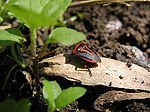Colorado potato beetle
| Colorado potato beetle |
|---|

|
| Scientific Classification |
|
| Binomial Name |
|
Leptinotarsa decemlineata |
The Colorado Potato Beetle is a small black and orange striped species of beetle. They have a hunger for all kinds of different plants including crops planted by humans. They have a low tolerance for climate change even though the female can lay up to 350 eggs a month. They are originally native to Mexico, and rarely, if ever, found near the Pacific coast. The larvae grow to be roughly one half of an inch long, when fully matured and can be found on the underside of leaves. The adult, when fully mature, can grow to be about one eighth of an inch. They lay their eggs one the underside of leaves to protect them from sun rays. The eggs are laid in clusters of about 20.[1]
Anatomy
Adult beetles are normally yellow with five vertical black stripes on their back. They have rounded wing covers like ladybugs, and are about 3/8 in long.They can lay up to 800 eggs on the underside of leaves. Up to three times a year.[2]
The eggs are normally a yellow-orange color. It takes a maximum of 4-15 days for the eggs to hatch into larvae. When the larvae have hatched, they have six legs, and are about 1/8 to half an inch long. They resemble a kind of hump-backed reddish-tan potato with two rows of black spots on both sides of their body. They eat plants and can cause lots of trouble if their population is high. They burrow several inches into the ground, and remain there for a period of about two weeks. While they are in the ground, they quickly grow into the adult stage of their life cycles.
Beetles in general have a set of compound eyes that display amazing adaptability. In other beetles, such as the Whirling beetle, the eyes are split to allow them to view both above and below the waterline. [3] They have hemolymph instead of blood, which is, a body fluid that acts as blood in most arthropods[4]. They have antenna that are normally for smell but can also be used for touch. Their hind legs are enlarged for jumping purposes. [5]
Reproduction
The Colorado Potato Beetle has sexual reproduction, and complete metamorphosis.
- Adult- The adult beetles burrow several inches into the ground, until spring when they come out of the ground. They eat the new, baby plant, and mate. The females lay their eggs on the under-side of the host plant to protect the eggs from the UV rays of the sun. [6]
- Eggs- The Eggs are shaped like little yellow footballs.[7] Colorado Potato Beetles lay a mass of 20-40 eggs, although most adult females can lay up to 300 over a four to five week period. For the eggs to hatch, the climate has to have moderate temperatures and humidity.
- Larvae- The Colorado Potato Beetle has small red colored larvae that can grow to be about an inch long when they are fully matured. The Larvae normally have two rows of black dots going down the bottom of their sides.
- Pupae- They look like little yellow rock-like creatures.
Ecology
The Colorado Potato Beetle mainly eats the foliage of, Solanum carolinense or Nightshade plants. They also eat eggplant, tomato, pepper, tobacco, ground cherry, belladonna, thorn apple, and more.[8] They have multiple predators, such as the Ladybird, and the Two-spotted stink bug (seen in picture at left). These predators feed on the larvae and eggs of the Colorado Potato Beetle. The Beetle is a very small bug, and has a numerous amount of predators. But just the same, they can cause a whole lot of damage to a crop of their favorite foods.
Pest control of the Colorado Potato Beetle generally depends on pesticides, costing US growers about $150 million each year in losses and insecticide cost. Concerned that the beetle may adapt to some poisons, scientists are looking for biological controls. The USDA Agricultural Research Service is looking at the parasitic wasp Edovum puttleri of the Eulophidae family[9]. Female wasps insert their eggs inside the beetle's eggs so the growing wasp larvae will have food, but this also has the result of destroying the beetle eggs. [10]
It was also discovered that a ground cover mulch called hairy vetch (Vicia villosa of the Legume or Fabaceae family)[11] helps to control the beetles almost as well as pesticides. The mulch seems to limit movement of the beetles on the ground.[12]
 Browse |
References
- Colorado potato beetle Multiple authors, Wikipedia.
- Beetles William Vann, multiple publishers, 2005-April 2008.
- Beetle History and more Many authors, Publication Number: EENY-146, July 2000--Latest revision: August 2007.
- Journal about the beetle Christine A. Armer, Rapid Communications, pp. RC137142, March 16, 2004
- More information about the beetle Multiple authors, Publication Number 444-012, April 2005
- Life Cycle and Damage Dr. Richard A. Casagrande, URI Department of Plant Sciences, 1999
- Scientific classification Not available information
- Hemolymph Many authors, Dictionary
- Beetle New World Encyclopedia. Multiple authors, August 29, 2008



